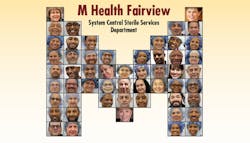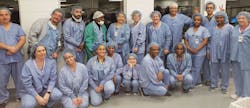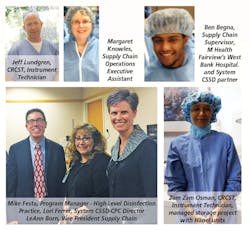M Health Fairview carries torch for pioneering performance
Back in the late 1980s, Richard Huntley, System Director, Central Processing, Minneapolis-based Fairview Hospitals and Healthcare Services, mentally harbored a novel idea. Instead of overseeing sterile processing of surgical instruments at multiple hospitals, why not centralize the process for all of them at one facility?
By early 1991, Fairview launched the radical endeavor, ultimately investing $6.2 million into the project and anticipating a 21 percent return on investment, according to Huntley at the time. They remodeled an 8,000-square-foot vacated laundry footprint at one of the hospital campuses to accommodate a new decontamination, assembly/inspection and sterilization area, which became the Fairview Central Processing Center (CPC). “The emphasis from day one was on improving quality and service, not cutting costs,” he told Healthcare Purchasing News in the May 1994 edition. (Editor’s Note: For a blast from the past read the full story online https://hpnonline.com/21133896)
Fairview’s new venture motivated one prominent consultant to declare with seeming prescience: “I think this is going to be the way most of us do business within the next 10 years.”
During the next quarter-century, the CPC at Fairview, recently rebranded as M Health Fairview as a nod to its relationship with the University of Minnesota Hospitals and Clinics in 1997 and its affiliation with the University of Minnesota, expanded to serve six acute-care hospitals and a growing number of clinics and surgery centers under the leadership of two professionals. Huntley was able to witness first-hand the growth of the CPC vision until his passing in September 2012. Even so, he had charged his successor, Lori Ferrer, CST, CRCST, to take the baton and run with it, encouraging her to propel the CPC team to higher levels of success and eventually nominate the team for consideration for Healthcare Purchasing News’ Sterile Processing Department of the Year.
Under Ferrer’s leadership, 2020 became their year.
Ferrer, who joined M Health Fairview in January 2012, marvels at the CPC’s foundation and roots. “This required a significant investment in people, space, equipment, inventory and the creation of processes that could efficiently and effectively handle the surgery and delivery volumes of the time,” she recalled. (Editor’s Note: For the list of suppliers that helped along the way, read the sidebar, “M Health Fairview System CSSD team salutes supplier partners as instrumental in success” below.)
Since the onset of the 21st century, the CPC added processing capacities to handle the volume growth and service expansion to more facilities, which added complexity to the organization’s processing model, according to Ferrer. In 2006, they added “turn centers” at each of the Fairview sites as a way to respond to escalating customer requirements stemming from a variety of issues, Ferrer indicated. They include the growth in number, volume, diversity and complexity of surgical procedures, including minimally invasive and bariatric procedures; the growth in number and complexity of orthopedic instruments; increased requests for on-site processing capabilities to decrease turnaround time and respond to rapidly changing schedules; the lengthy processing cycle time for heat-sensitive instrumentation and the “ever-increasing desire to improve patient safety,” she added.
Ferrer’s team continues to build out their centralized processing expertise to bring in more departments and facilities into the centralized instrument processing; and surgical set process, including onboarding at least 50 additional offsite Fairview Medical Group clinics.
For the continued growth and development of the System Central Sterile Services Department, formerly known as the CPC; for the system-wide standardization and ongoing care and detailed tracking of instruments and surgical sets; for its continuing collaboration and partnership with surgical services and supply chain; and for the internal and external educational, informational and training tours it conducts to spread its operational efficiency gospel, M Health Fairview System Central Sterile Services Department earned the 2020 SPD Department of the Year Award from HPN.
Growing pains
As with any projects or processes that push people out of their comfort zones, M Health Fairview’s System CSSD team has navigated and negotiated through considerable growing pains.
“There were many good processes implemented for quality instrument processing,” Ferrer noted, “[but] great process improvements are only as good as the surveillance and efforts that follow to maintain best practices.”
For example, in 2004, the OR areas agreed to participate in a post-case handling project where instruments were to be soaked in an enzymatic solution, rinsed to remove all of the gross soil and to remain wet until their processing, according to Ferrer. They added automatic enzymatic soap dispensers at all sites, conducted post-case audits at all sites and recorded findings as incident reports to share. A system sterilization liaison group meets monthly to review all recorded errors and discusses options for resolutions, she added.
Along the way, Ferrer acknowledges they have faced some challenges even after decades of an established system in place.
“[There are] surgeons who want sole use of the instruments they regularly use,” she said. “We are communicating with the surgical teams about the advantages of using standard surgical sets. One of our surgeons has agreed to help initiate conversations with the surgeon groups about the importance of using the centralized standard surgical instrument sets.” [Editor’s Note: See Ferrer recognizes several helpful surgeons in the sidebar, UpClose with M Health Fairview’s SCSS leader at https://hpnonline.com/21134414].
Back in 1993, three Fairview facilities started the set standardization process by identifying commonalities between each hospital’s preferences and creating sets to meet everyone’s needs, according to Ferrer. She highlighted that one team member – Mari Jo Williams – worked on the set standardization project 27 years ago and continued participating on the team in 2019! Fairview standardized to 81 instrument sets from 464 sets in 1993, Ferrer noted.
“Through the years and as sites were added to the centralized model of surgical sets, minor changes were made to the sets,” she said. “Sets were added throughout the years, and at one point we distributed 101 various standard sets.” Then in 2018 and 2019 they assembled a group to begin looking at “modernizing” the sets, which were classified by service and changes discussed by the appropriate clinical and administrative experts. The Surgical Set Revision (Modernization) Workgroup met for a total of 64 hours in 2018 and 27 hours in 2019, she added. Excess instruments either were repurposed in other sets, retained as back-up stock or shared with site CSSD teams, according to Ferrer. Those that were no longer used were sent to the missions, she added.
Improving communication and collaboration with OR teams remains an ongoing exercise that involves site visits or rounding with the sterile processing and OR teams on a frequent basis and providing tours to the OR staffs and site CSSD team members to better understand the workflow. While System CSSD reports to Supply Chain, the site CSSD teams report to their respective facility ORs, according to Ferrer. System CSSD collaborates with the individual site CSSDs that focus on minimally invasive surgical devices and related technologies.
One benefit of this is the frontline processing team members observe the set-up and use of the instruments they process for surgical patients, according to Ferrer.
System CSSD also strives to ensure that OR areas continue to perform point-of-use cleaning, and that sites carry out the required enzymatic soak before returning instruments to System CSSD. Ferrer’s team accomplishes this through frequent auditing and quality reporting. They also work to identify any challenges and hurdles that surface in processes and workflow via automated tracking systems with user-friendly programming.
“We continue to work on standard work practices to streamline all steps in our processing cycle,” Ferrer noted. “Audits are continually updated and performed on our processing steps to ensure accurate quality instrument sets for our patient’s clinic and surgical procedural needs.”
Tour de force
The System CSSD recognizes that its reach and responsibilities extend beyond instruments and surgical sets.
“It’s easy to get consumed in the everyday whirlwind of our work,” Ferrer noted. “What’s important to remember is how we are meeting our customer needs and concerns who receive the services that we provide. Everything moves at warp speed in our industry, and each day is filled with variables and new challenges. As healthcare systems combine and the sum of the whole enterprise keeps expanding, it is harder and harder to be able to put a face with a name and feel the urgency of what our customers need to successfully complete their tasks – tasks that are imperative to the quality care of our patients.”
During the past year alone, 83 percent of the System CSSD team attended site CSSD tours and surgical case observations, “allowing them to see the importance of their work,” Ferrer indicated. “Going to the Gemba, the actual place where the work happens, we as CSSD leadership tour our customer areas to be better informed of the process of instrument distribution and retrieval from the end users.”
Working with OR leadership, System CSSD had set a goal in 2019 to have 80 percent of the frontline team observe a surgical procedure – rotating one frontline person from each shift with a manager or the director at one of five hospital sites within the system, according to Ferrer. Each of the team members was given a worksheet to help better understand the workflow, she added.
“The more that we know about each other’s work, the better we can serve each other’s needs,” she said.
Ferrer also welcomes and appreciates customer experience rounding. “System CSSD always encourages staff from surgical sites to tour our area to help them understand our process,” she said. “Leadership from other areas of the hospital tour our CSSD and are fascinated to learn about sterile processing. We recognize the incredible importance in understanding our customer’s needs and inviting them to understand and tour our process. Team members from our System CSSD team and our customer team members have been enlightened on the whys and the hows of particular shortages. Working together we are able to improve our workflow and decrease shortages.”
Ferrer’s System CSSD team works closely with Supply Chain in that Supply Chain retrieves used instruments from the designated soiled utility areas in the clinics, ancillary areas and on the patient floors, according to Ferrer. They place the used instruments on a closed cart and send to System CSSD for reprocessing. System CSSD returns the instruments to Supply Chain to stock the user areas throughout the facility, according to Ferrer.
Together, the two departments have honed the process to both an art and science.
“The managers, supervisors and our department facilitator are meeting our customers in the user areas to understand the flow of the instrumentation to better meet their needs,” Ferrer said. “Additional communication is shared with the user areas regarding the appropriate levels of stock on hand, disposable versus reusable instruments, instrument care, handling and education.
“Working together and walking through the process with our Supply Chain partners and with our customer user areas has improved the understanding for everyone involved in the process,” Ferrer continued. “A clearer understanding has enabled all of us to communicate more frequently and troubleshoot our hot spots of missing instruments and the delayed return of instruments as it impacts the needs tomorrow in our clinics and the hospital ancillary areas.”
Next on the docket: Distributing requested instruments to M Health Fairview’s eye clinics directly from the System CSSD to eliminate the need of maintaining inventory in the site Supply Chain CS areas, according to Ferrer. This should help improve instrument inventory management and fill rates as well as free up valuable space to be used for other purposes, she added. Ferrer’s team will use this experience to determine how and when to expand System CSSD-direct services to other areas.
Setting a standard
Ferrer’s team continues to push for productivity improvements. In fact, during the last two years, the team has been working on keeping the numbers of sets to assemble below 200, according to Ferrer.
“Priority list of need plus what backup we incurred resulted in a delay of the sites receiving sets at least eight hours before the scheduled surgery procedure for case cart assembly,” she said. “We decided as a team [during the last six months of 2018] our clean average was at 418 with a peak of 664 sets to be assembled. In 2017 we had set a goal of less than 300 and accomplished this in our first month. Then we set our new goal of less than 200 sets average clean-hold per month. At the end of 2017 we were at an average for the 12 months at 233 sets.”
System CSSD includes a team of drivers that operate temperature-controlled trucks to deliver and pick up instruments on five routes for all hospitals and non-acute care centers, Ferrer noted. They also have in-house driver assignments for supply replenishment and delivery to on-site customers.
Not surprisingly, Ferrer and System CSSD leaders stress the benefits and value of ongoing education, including inservices, online programing, podcasts, rotations and rounding and tours as well as monthly team meetings where they explore “hot topics” and departmental and organizational updates. Since 2017 all new employees hired must achieve their CRCST certification within a year of hire, she noted. Ninety-two percent of our team members required to have certification are CRCST-certified with three individuals awaiting their accomplishment of certification within their first 12 months of employment, she added.
There's more to the story:
- M Health Fairview’s System Central Sterile Services team leader on making a difference
- Fairview breaks new ground with central processing facility (May 1994 HPN)
- Fairview puts the ‘I’ in teamwork: Investment (July 2017 HPN)
- Profile on Stony Brook (NY) University Hospital, which earned Honorable Mention
Photos courtesy of Lori Ferrer and Paul McCollum, Instrument Tracking Manager.









